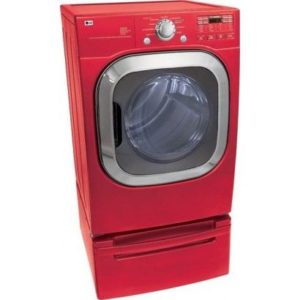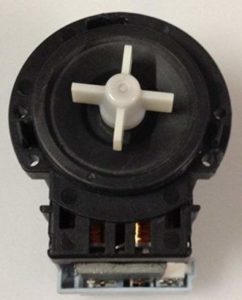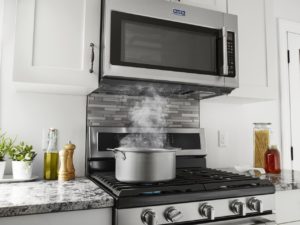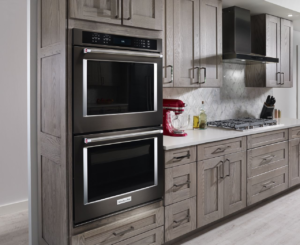LG Dryer Faulty Gas Burner Valve Assembly
**NOTICE**
Due to the danger and complexity of electronic equipment repair, the following technical tip is intended for professional reference only. Please refer to manufacturer’s recommendations as Encompass does not guarantee the accuracy, reliability or safety of this information.
How to Replace a Faulty Gas Burner Valve Assembly in a LG Dryer
If clothes are still wet after completing the dry cycle in LG dryer model DLG2602R, it is likely due to lack of heat. This is a common dryer issue that could be caused by numerous possible malfunctions.
 Once determining there are no issues with the high limit thermostat, flame sensor, thermistor and ignitor, consider examining the gas burner valve assembly, which supplies gas to the dryer burner. A malfunctioning valve assembly won’t administer gas, which means the dryer won’t heat.
Once determining there are no issues with the high limit thermostat, flame sensor, thermistor and ignitor, consider examining the gas burner valve assembly, which supplies gas to the dryer burner. A malfunctioning valve assembly won’t administer gas, which means the dryer won’t heat.
Before starting any dryer repairs, unplug it from the wall and turn off the gas supply valve. Never attempt a repair without wearing proper safety gear, such as work gloves and goggles. As with all technically difficult and potentially dangerous repair, this repair is best left to a
specialist.
Steps to Replacing Gas Burner Valve Assembly
- Pull LG dryer forward and away from laundry room wall. On the back of the appliance, unthread screws that secure the top panel to dryer. Once screws are out, pull panel toward you, and lift it up and off dryer.
- Now, disassemble the control panel. (Before disconnecting wires, it’s a good idea to take a photo of all wire connections to assist in easily reconnecting them during reassembly.) Start detaching the wire harnesses from the back of the board. Once all wires are disconnected, take out the screws that hold the control board console to the dryer, and then pull console off front of dryer.
- With control board removed, disconnect the door switch located near the top center of the door frame. Next, open dryer door and
unthread screws that hold front panel to lint screen housing. Once the screws are out, close the door and unthread screws at the top of the front panel. Then, carefully tilt front panel backward, and pull it up and off dryer. - Now, remove control panel bracket off the dryer. First, locate dryer light bulb and disconnect wire harness running to it. Next, locate two wiring retaining clips on the back of the bracket. Take out the wires being held in the retaining clips. Then, remove screws holding the control panel bracket to the front of dryer, and pull bracket off dryer.
- Near the bottom of dryer, disconnect wire harness to the moisture sensor. Once the wires are separated, unthread screws that
secure bulkhead to dryer and carefully lift off. - Reach in between dryer floor and dryer drum to take drive belt off idler pulley and drive motor pulley.
- Grab drive belt on top of dryer drum and use to help guide drum out of dryer cabinet.
- With drum removed, locate gas burner valve assembly in the cabinet’s lower right hand corner. Disconnect wire harnesses running to valve assembly terminals. With a Phillips screwdriver, unthread screws that secure gas line to burner valve. Once screws are loose, carefully pull gas line off burner valve. Next, take out screws holding valve assembly to mounting bracket, and then take gas burner valve off mounting bracket and out of dryer cabinet.
- Before installing new valve, take the orifice off the old gas burner valve and place on new component. Once orifice is securely
attached to the new gas burner valve assembly, proceed with installation process. - Place gas burner valve assembly on mounting bracket, ensuring screw holes are lined up on bracket with screw holes on the valve
assembly. Then, replace screws used to secure gas burner valve to mounting bracket. Next, align gas supply tube with burner valve, and insert tube into the valve. Once tube and valve are connected, rethread screws taken out earlier to secure the tube to the valve. To complete installation, reconnect gas burner wire harnesses to valve terminals. - Before putting dryer back together, take a moment to check for any gas leaks. To do so, fill a spray bottle with soapy water, and turn gas supply valve back on. Then, spray gas burner valve with soapy water. If any bubbles form, a gas leak is present, meaning the connection is not tight enough. At this point, turn off dryer’s gas supply, and try tightening the tube and valve coupling. Once you’ve adjusted the union, turn gas back on, and run gas leak test again. If no bubbles appear, the gas leak should no longer be an issue. If bubbles are still forming, DIY consumers should contact a dryer repair technician to further inspect.
- After testing for leaks and none are found, turn off gas running to the dryer, and start reassembling the dryer. Pick up dryer drum and carefully guide it into the dryer cabinet, ensuring the drum back sits on the drum rollers. Then, reach in between the drum and dryer floor to rethread drive belt on idler pulley and drive motor pulley. Make sure belt is installed in zigzag formation.
- Retrieve dryer bulkhead, and align with front of dryer. Then, secure part with screws taken out earlier. With bulkhead in place,
reconnect moisture sensor wire harness, and light bulb wire harness. - Now, reattach control board bracket. Once bracket is in place, pull door switch wire harness to front of dryer through one of the
openings on the bracket. Then, snap wire into retaining clips on back of the bracket. - Grab dryer front panel and line up with the dryer front. Before laying panel flush, reconnect door switch harness to door switch, and
finish installing front panel. After adding screws to secure panel, open dryer door, and rethread screws that connect front panel to lint screen housing. - Snap control panel back on dryer, and reattach screws removed earlier. Finish installing control panel by reconnecting wire harnesses that run to the panel back.
- Finally, reinstall the dryer’s top panel, plug in the dryer and turn on gas supply valve.
Special thanks to Fred’s Appliance Academy for this helpful tip!




 Depending on available space, you may also want to disconnect the water lines and pull the drain line connection out of the wall. During this repair, the machine must be tilted back to reach the circulation pump motor.
Depending on available space, you may also want to disconnect the water lines and pull the drain line connection out of the wall. During this repair, the machine must be tilted back to reach the circulation pump motor. Accessing the Switches
Accessing the Switches Then, remove the upper access panel by inserting the screwdriver into the central hole along the bottom and disengaging the locking tab by pushing it up. Pull the panel out and set aside. The water tank at the back of the refrigerator’s interior is now accessible, as well as the filter head running up the back into the ceiling.
Then, remove the upper access panel by inserting the screwdriver into the central hole along the bottom and disengaging the locking tab by pushing it up. Pull the panel out and set aside. The water tank at the back of the refrigerator’s interior is now accessible, as well as the filter head running up the back into the ceiling. How to Access Broil Element and Oven Sensors
How to Access Broil Element and Oven Sensors